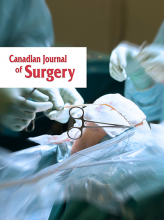I would like to respond to the commentary “Oncoplastic and reconstructive breast surgery in Canada: breaking new ground in general surgical training” by Peiris and colleagues.1 First, I completely agree with the notion that breast reconstruction is beneficial for many women undergoing mastectomy or significant volume loss with breast-conserving surgery. The corollary of this is that all women facing this type of surgery must be informed of all treatment options. Both Alberta2 and Ontario3 (using evidence-based approaches with multi-disciplinary panels that included breast oncologists and plastic surgeons) have recommended standardized information about breast reconstruction early in the decision-making process, encompassing all types of breast reconstruction, including implant-based, autologous flap, and combination reconstructions (i.e., autologous with implant).
In Canada, the only surgeons trained to discuss and provide all of these options are Royal College–certified plastic surgeons. This expertise is currently embedded in the Royal College’s objectives of training in plastic surgery and will be a key part of competency by design at all levels of training after transition to discipline. While volume-replacement breast reconstruction is part of the surgical practice of some oncologic breast surgeons in Europe, this is not the case in Canada. In fact, there are many aspects of surgical care that are different between the jurisdictions. One obvious example is the role of a trauma surgeon in Europe which involves treating extremity, abdominal, thoracic and central nervous system trauma. In Canada, this spectrum of expertise rests in multidisciplinary teams, and there appears to be no reason to change.
The same holds true for breast cancer surgery and breast reconstruction. Peiris and colleagues state “a lack of plastic surgeons specializing in breast reconstruction is often cited as the main reason for low rates of immediate breast reconstruction in Canada. It therefore stands to reason that increasing the number of surgeons performing immediate breast reconstruction will increase rates.” This statement is erroneous in multiple aspects. Although all plastic surgeons in Canada are trained in breast reconstruction, Platt4 found that there was a strong correlation between rates of breast reconstruction and the presence of a plastic surgeon in the hospital where the mastectomy was done; that is, the issue is not that plastic surgeons lack breast reconstruction skills but rather the lack of plastic surgeons. However, there are equally important factors limiting the rates of breast reconstruction, including a persistent and erroneous belief among ablative surgeons and medical and radiation oncologists that reconstruction will delay adjuvant therapies or “hide” tumour recurrence.5 Finally, a lack of dedicated operative resources for breast reconstruction is a significant impediment because it requires complex coordination among general surgeons and reconstructive surgeons, and there is a legitimate concern on the part of general surgeons that their already scarce operative time will be taken up with potentially long reconstructive procedures after they have completed a mastectomy. In our institution, dedicated ablative/reconstructive operating time allows both plastic surgeons and general surgeons to run concurrent clinics and surgical lists once they have completed their portion of the breast procedure.
Our position papers6,7 argue for general surgeons, plastic surgeons, radiologists, medical oncologists, radiation oncologists and dedicated nursing staff to work in a multi-disciplinary team. We agree that the general surgeon trained in breast repositioning techniques should complete level I and level II surgery and that this represents a significant advancement in breast-conserving surgery. However, we strongly endorse that volume replacement (e.g., implants, autogenous tissue) and significant volume reduction (e.g., breast reduction) only be done by a combined general surgery and plastic surgery team. This supports the concept of the right surgeon doing the right procedure at the right time, ensures that women will be informed of all of their reconstructive options, takes advantage of the expertise of all team members and provides the best outcomes for patients.
An optimal future for patients does not rest with physicians “breaking new ground” outside the scope of their training, but instead in modifying the health delivery system to foster integrated, multi-disciplinary teams in which shared learning, innovation and expertise become routine. For instance, to address the regional variation in rates of breast reconstruction, we are investigating care pathways that would allow mastectomies to be done in community hospitals followed by expedited assessment for so-called “delayed immediate reconstruction.” The care of patients with breast cancer is a “team game,” and we encourage all surgeons caring for these patients to become involved in the formation of a team in their community and region.
Footnotes
Competing interests: None declared.






